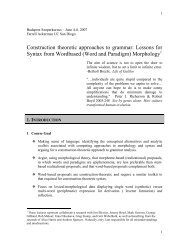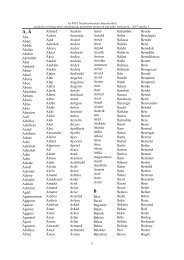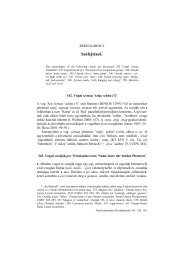Nyelvtudományi közlemények 91. kötet (1990)
Nyelvtudományi közlemények 91. kötet (1990)
Nyelvtudományi közlemények 91. kötet (1990)
Sie wollen auch ein ePaper? Erhöhen Sie die Reichweite Ihrer Titel.
YUMPU macht aus Druck-PDFs automatisch weboptimierte ePaper, die Google liebt.
116 EEVA KANCiASMAA-MINN<br />
dialects the form joyau. In principle a noun could survive only as a certain<br />
caseform. The older Cheremis language, however, reserves the genitive case<br />
for animate conceptions — inanimate adnominal genitives are extremely<br />
rare. Adverbial genitives, on the other haiid, are quite common: the ending<br />
an is the usual means for turning adjectives into adverbs, and a few substantives<br />
might also be involved. So e.g. the adverbial genitive or instructive<br />
of the noun sör 'edge' indicates position in the following utterance: samasßlakat<br />
söran kijat ulmas 'The braiiiblers were lying edgewise' (Paasonen-<br />
Siro (1948. 7). There exists in fact a Compound ßozan-jolas 'panties with<br />
open legs' from ßoz 'brandi', where the instructive occurs as the first part<br />
in a noun Compound. Thus joyau-ßüt might translate something like 'in<br />
condition-of-stream-water' and there is one exam])le of joyau separated from<br />
its companion word and occurring as a nominal predicate: Oriayauai ßütsö<br />
pes-at joyau 'The water of the river Oria is very turbulent' (Beke 1961. 320).<br />
These explanations, however, sound very far-fetched when bearing in mind<br />
that there are several words in Cheremis with nominative forms ending in<br />
an: sußau 'lever', porsan 'silk', jalkau 'flash', tolkau 'wave'. Anyway, the<br />
likeliest explanation is that joyau as well äs joyà represents a nominative<br />
form and that the KB variant lias dropped the final -n.<br />
C. Syntactic évidence. Since, as mentioned above, the Cheremis languages<br />
does not traditionally recognize genitives from inanimate words,<br />
Compounds with the first part in the genitive are extremely rare. There<br />
exists a désignation for wild geese juuiau-kombo 'the goose of God (or of<br />
heaven)', where the first part of the Compound might be considered animate<br />
or at least a personification, and the word for children's panties ßozan-jolas,<br />
mentioned above, where the genitive does not indicate possession but condition.<br />
In addition, there are couple of Compounds with the genitive of a verb<br />
stem as the first part: suzen-ij 'famine (starve-year)' and socau-aßa 'beborn-mother<br />
(a deity who helps at child birth)'. Surprisingly, Ivan Galkin<br />
includes joyau-ßüt among thèse last mentioned (1864. 169), although joyau<br />
could not possibly be taken for a gerund, i.e. a genitive of the verb stem:<br />
the form in question is joyen from joyem 'to flow'. With référence to the<br />
preceding: if there would exist in the saine dialect parallel forms of joya and<br />
joyau, the Compound joyau-ßüt might be analyzed as having its first part<br />
in the genitive, but since that is not the case, joyau-ßüt is to be interpreted<br />
the common type of nominative + nomintive.<br />
D. Lexical évidence. The ordinary désignation for river in Cheremis is<br />
eyer, even that considered a Chuvash borrowing (Paasonen-Siro 1948. 18):<br />
joyau-ßüt is restricted to poetica! use. In Chuvash juxuu-sav or joxansav<br />
is the common word Compound for 'river' (RChS 672, ChllS 643). The<br />
Chuvash expression translates word for word as 'flowing water', the first<br />
Nyelvtudományi Közlemények <strong>91.</strong> <strong>1990</strong>.




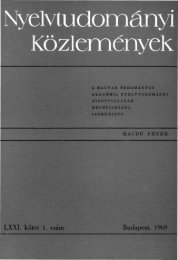

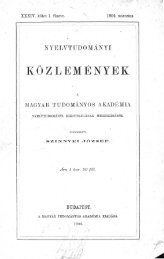
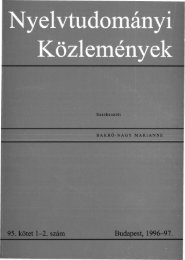
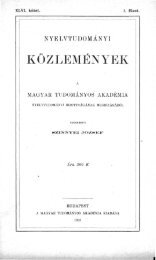
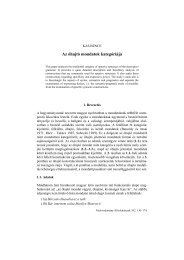
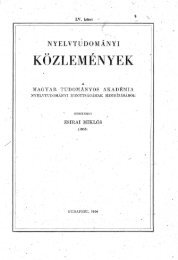
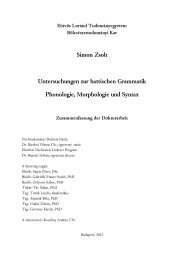
![Gósy Mária: A [p, t, k] mássalhangzók zöngekezdési ideje Bevezetés ...](https://img.yumpu.com/15682849/1/190x245/gosy-maria-a-p-t-k-massalhangzok-zongekezdesi-ideje-bevezetes-.jpg?quality=85)

